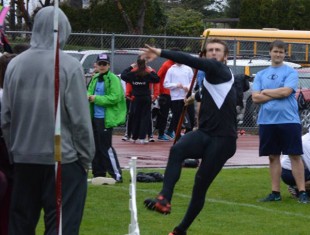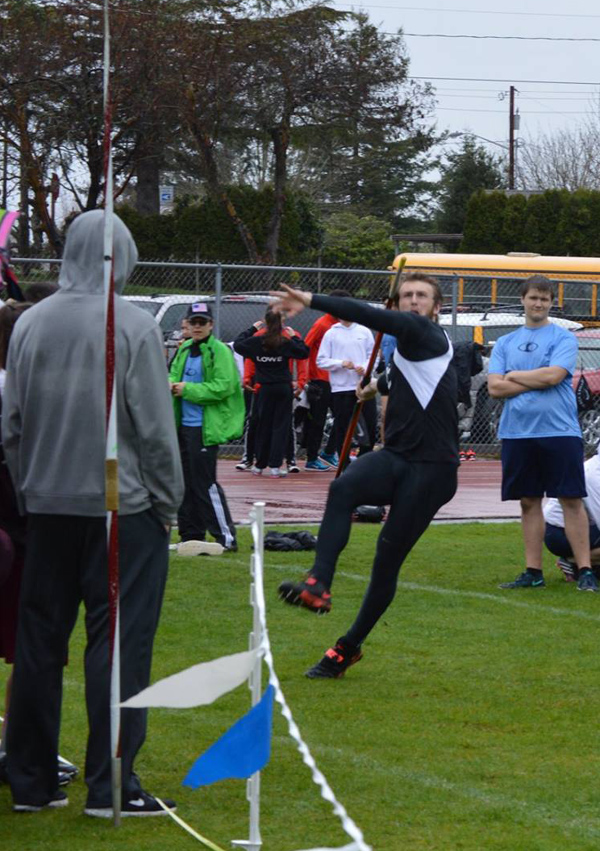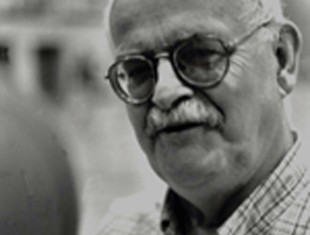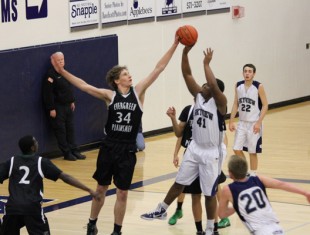HUDSON KEFFER
By Terry Mosher
Editor, Sports Paper
How far can he go? That is the question that will hang out there all spring as Central Kitsap senior Hudson Keffer takes aim at the javelin crown in the 3A track and field championships that will be held at Mt Tahoma from May 28-30.
Keffer is a two-time runner-up in the 4A javelin to Tahoma’s Denham Patricelli, who has graduated and is on scholarship at the University of Washington. Because Central Kitsap has dropped down one classification to 3A, Keffer will win a possible javelin title in the 3A competition.
To clear the air, Keffer earlier this spring established the West Sound and CK school record in the javelin with a throw of 210 feet. That throw came on April 2 on the grass at Capital High School. It propelled Keffer to the national lead among high schools.
Keffer followed that throw up with a winning 201-01 effort at the Lil’ Norway Invitational at North Kitsap in which his throws coach Bill Braun said was made into 30 mph headwinds.
To complicate matters just a wee bit, in 2002 this state went to a different javelin designed for safety. The new javelin does not travel as far as the old one. That is telling in the West Sound record of 225-02 that was set in 1972 by the late Tom Tennis, who was then a senior at Central Kitsap. The state record with that javelin is 239-01 set by Peninsula’s Tom Sinclair in 1975.
The state 3A meet record with the “new javelin” was set in 2009 by Bellevue’s Robert Hintz with a throw of 211 feet. The all-time record in the state with the “new” javelin is 253-0 set in 2012 by Heritage’s Sean Keller, who is now at Spokane Community College. And the national high school record is 255-0 established by Sam Crouser of Gresham (Oregon) High School in 2010.
It is all a little confusing, but the point of this is that Keffer is on track to do some special things with the javelin if he continues his upward arc. For example, Keffer as a sophomore finished second in the state to Patricelli in 2013 with a throw of 180-01 (Patricelli threw 205-07). Last year, Keffer improved to 192-08 at state to again finish second to Patricelli’s 204-06.
Keffer does not take throwing the javelin lightly. He is a serious student in the classroom (3.5 grade point) and just as serious with whatever he does, including his biggest hobby outside the javelin of hiking, which he does frequently in the Olympics and also at least once to old Monte Cristo mining site on Mount Baker.
He works hard in the weight room building up strength and studies video of Olympic throwers and takes his work with Braun extremely serious. It’s that work ethic and his ranking in the state and in the country that first attracted the attention of David Dumble, who in his 14 years as throws coach at Arizona State University has sent a slew of discus and shot put throwers, both male and female, on to big things, including 23 NCAA titles.
“He was on the list of best throwers in the country,” says Dumble. “He was one of the top recruits in the country for javelin, and I’m always looking for top athletes.”
The feeling was mutual. Keffer was also looking for a good school to continue on with the javelin, and ASU and its warm climate was very attractive to him.
“I had offers from Washington and Auburn, but I really liked ASU and the coaches there,” says Keffer. I like Dumble. He’s easy to relate to and he’s had a lot of good throwers. Everyone seems to buy into the program and it feels like a family. It made me more comfortable going there and knowing I would have this group to train with every day.”
So in November of last year, Keffer signed a partial athletic scholarship and also has obtained an academic scholarship.
Keffer tends to throw better in meets than in practice, and he sees 225 feet as a reasonable goal this season. That goal is contingent on having the proper runway space to get off throws, something he will plenty of once he gets at ASU and begins competing in the Pac-12 against top programs in the country like Oregon and USC.
“Once I get a good javelin runway with good weather, and good competition, there is no doubt I will go further,” Keffer says.
It’s a continued amazement how we so often stumble on something accidentally and it turns our lives around. That’s what happened to Keffer. He was a quarterback in football and a 400 runner in track and field at Ridgetop Junior High and when he got to Central Kitsap continued on that football course his sophomore year, but the last two football seasons switched to wide receiver to protect him from hurting his arm.
That protection might not have been necessary if he had stayed a 400 runner (he still runs a leg of the 1600 relay), but close friend Makaleb McInnis, who goes to Olympic High School, urged him to consider throwing the javelin, and he thought why not?
“Makaleb’s father (Bobby McInnis) is a throws coach and I wanted to hang out with Makaleb and his dad and I had a pretty good arm,” says Keffer. “So I was okay when I first started throwing, but it took a while to really get the technique before I got a lot better.”
Keffer and Makaleb threw the girls’ javelin at Ridgetop. They really didn’t have coaching, but just kind of learned how to throw it on their own. Once Keffer got to Central Kitsap he quickly was taken under Braun’s wing
“He’s helped me a ton,” says Keffer. “He fixed my technique and it is completely different. You use a lot more lower body and good hop drive and solid block, which is really when it started to make a difference.”
The difference in distance jumped from a pr of 187-09 his sophomore year to 206 pr last year and now to 210 and counting. His 206 came last summer in Eugene at the Junior National Championships. He was seeded 12th with a distance in the mid-190s and was at 17 years of age the youngest by far among the competition. Yet, he threw the 206 to finish fourth.
Braun works at Puget Sound Naval Shipyard and became entangled in the CK track and field program when his daughter Bethani competed in the shot put and discus, graduating in 2009 after that spring finishing eight at 4A state in the discus with a throw of 109-05.
Some of the work Braun does with Keffer is extensive use of video to correct technique and to enable them to look at how others like Jan Zelezny, the world record holder at 323.097 feet, in the javelin, do it.
They also use The Finn Flyer, a 470-gram weight javelin (regular javelin weights 800 gram) that when thrown incorrectly will go right or left instead of straight. So by using it a thrower can find the correct release point because if he doesn’t then it veers off left or right.
“Just any little amount you are off on your proper release can translate to a 20-25 feet difference,” says Braun. “And (Keffer) knows as soon as he throws it whether it is a good throw or not. So it’s important process in getting the proper throw.”
In addition, The Finn Flyer, because it weighs less than the regular javelin, puts less stress on the arm.
Another change that has occurred is a different javelin. The high school has used a 60-meter javelin, which tops out in the high 190s in terms of feet a competitor can throw it. Braun, with the permission of the school and Keffer’s dad, purchased a 90-meter javelin (Keffer’s dad pay him back). That javelin translate to about a limit of 250 feet.
Once Keffer gets to ASU in August, he will find it’s just him and another thrower of the javelin. Tylar Deveraux, who is from Hillsboro High School in Portland, Ore., is red-shirting this year after undergoing shoulder surgery. So it will be just him and Keffer next season, which means they will probably not only get special attention but also should connect on at least one level – the javelin.
“His potential is huge,” says Dumble of the 5-11, 185-pound Keffer. ‘He’s still young. He has more room for improvement. The more reps he gets, the more he practices and gets stronger and gets into a rhythm, he has a chance to be in the top eight in the Pac-12.
“He’s a good kid, really works hard and is responsible. I’m really excited to have him here next year.”





